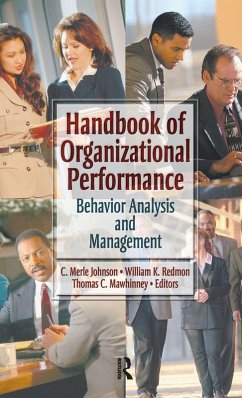William K Redmon, Thomas C Mawhinney, Carl Merle Johnson
Handbook of Organizational Performance
Behavior Analysis and Management
William K Redmon, Thomas C Mawhinney, Carl Merle Johnson
Handbook of Organizational Performance
Behavior Analysis and Management
- Gebundenes Buch
- Merkliste
- Auf die Merkliste
- Bewerten Bewerten
- Teilen
- Produkt teilen
- Produkterinnerung
- Produkterinnerung
The Handbook of Organizational Performance contains all the information you need to effectively manage your employees . Using the principles of industrial/organizational psychology, you will learn how to perform behavior analysis and management, how to determine criteria for performance appraisals, and how to establish leadership in the workplace. Enhanced with helpful charts, tables, and figures, The Handbook of Organizational Performance is an indispensable management tool and an essential text for students of business. To view an excerpt online, find the book in our QuickSearch catalog at www.HaworthPress.com.…mehr
Andere Kunden interessierten sich auch für
![Compensation and Organizational Performance Compensation and Organizational Performance]() Luis R. Gomez-MejiaCompensation and Organizational Performance180,99 €
Luis R. Gomez-MejiaCompensation and Organizational Performance180,99 €![Performance Through Learning Performance Through Learning]() Kurt AprilPerformance Through Learning180,99 €
Kurt AprilPerformance Through Learning180,99 €![Making Sense of Organizational Change Making Sense of Organizational Change]() Jean Helms-MillsMaking Sense of Organizational Change223,99 €
Jean Helms-MillsMaking Sense of Organizational Change223,99 €![The Sustainability and Spread of Organizational Change The Sustainability and Spread of Organizational Change]() David A. Buchanan / Louise Fitzgerald / Diane Ketley (eds.)The Sustainability and Spread of Organizational Change223,99 €
David A. Buchanan / Louise Fitzgerald / Diane Ketley (eds.)The Sustainability and Spread of Organizational Change223,99 €![Challenging Perspectives on Organizational Change in Health Care Challenging Perspectives on Organizational Change in Health Care]() Louise FitzgeraldChallenging Perspectives on Organizational Change in Health Care172,99 €
Louise FitzgeraldChallenging Perspectives on Organizational Change in Health Care172,99 €![Building an Organizational Coaching Culture Building an Organizational Coaching Culture]() Building an Organizational Coaching Culture172,99 €
Building an Organizational Coaching Culture172,99 €![Organizational Influence Processes Organizational Influence Processes]() Robert W. AllenOrganizational Influence Processes213,99 €
Robert W. AllenOrganizational Influence Processes213,99 €-
-
-
The Handbook of Organizational Performance contains all the information you need to effectively manage your employees . Using the principles of industrial/organizational psychology, you will learn how to perform behavior analysis and management, how to determine criteria for performance appraisals, and how to establish leadership in the workplace. Enhanced with helpful charts, tables, and figures, The Handbook of Organizational Performance is an indispensable management tool and an essential text for students of business. To view an excerpt online, find the book in our QuickSearch catalog at www.HaworthPress.com.
Produktdetails
- Produktdetails
- Verlag: Routledge
- Seitenzahl: 496
- Erscheinungstermin: 25. Mai 2001
- Englisch
- Abmessung: 222mm x 145mm x 30mm
- Gewicht: 750g
- ISBN-13: 9780789010865
- ISBN-10: 0789010860
- Artikelnr.: 25470789
- Herstellerkennzeichnung
- Libri GmbH
- Europaallee 1
- 36244 Bad Hersfeld
- gpsr@libri.de
- Verlag: Routledge
- Seitenzahl: 496
- Erscheinungstermin: 25. Mai 2001
- Englisch
- Abmessung: 222mm x 145mm x 30mm
- Gewicht: 750g
- ISBN-13: 9780789010865
- ISBN-10: 0789010860
- Artikelnr.: 25470789
- Herstellerkennzeichnung
- Libri GmbH
- Europaallee 1
- 36244 Bad Hersfeld
- gpsr@libri.de
William K Redmon, Thomas C Mawhinney, Carl Merle Johnson
Contents
About the Contributors
Contributors
Foreword
Acknowledgments
Part I: Foundations
Chapter 1. Introduction to Organizational Performance: Behavior Analysis and Management
Recurring Themes in the OBM Research Literature
Conclusion
Chapter 2. Principles of Learning: Respondent and Operant Conditioning and Human Behavior
Respondent Conditioning
Operant Conditioning
Verbal Behavior
Rule-Governed Behavior
Concluding Comments
Chapter 3. Developing Performance Appraisals: Criteria for What and How Performance is Measured
Problems with What to Appraise
The "How" Issues in Performance Appraisal
What Can Be Done to Improve Content and Method?
New Criteria for Criteria
Identifying What Should Be Appraised
Chapter 4. Within-Group Research Designs: Going Beyond Program Evaluation Questions
Scientific Method: Matching Research Questions and Designs
Drawing Inferences with Confidence
Within-Group Designs
Answering Program Evaluation Questions Using Within-Group Designs
Assessing Trends Over Time Using Within-Group Designs
Problems Using Within-Group Designs to Address Comparison Questions
Assessing Impact of Multiple Treatments: Alternatives to Asking Comparison Questions
Within-Group Designs in Perspective
Chapter 5. Schedules of Reinforcement in Organizational Performance: Application, Analysis, and Synthesis
The Basic Importance of Schedules
Schedules of Reinforcement: The Basics
Schedules of Reinforcement: The Research
Application, Analysis, and Synthesis
Theoretical Issues and Future Directions
Part II: Applications of the Behavioral Model
Chapter 6. Training and Development in Organizations: A Review of the Organizational Behavior Management Literature
The Importance of Instruction
Training Research
Comparison Research
Training and Motivation
Program Development
Critique and Future Research Directions
Conclusion
Chapter 7. Leadership: Behavior, Context, and Consequences
A Behavior Analytic Vantage Point on Leadership
Selection by Consequences As a Causal Mode
Contiguity- and Molar Correlation-Based Laws of Effect
Necessary Conditions for Leadership
Discussion and Conclusions
Chapter 8. The Management of Occupational Stress
Job Satisfaction
The Measurement of Job Stressors
Approaches to the Treatment of Occupational Stress
Treatments for Occupational Stress
Conclusions and Recommendations
Chapter 9. Pay for Performance
Variety of Plans
Behavioral Approaches to Performance-Based Pay
Common Elements
Future Research
Chapter 10. The Safe Performance Approach to Preventing Job-Related Illness and Injury
Current Approaches to Dealing with Safety
Reasons for Unsafe Performance
The Safe Performance Model
Summary and Conclusions
Chapter 11. Actively Caring for Occupational Safety: Extending the Performance Management Paradigm
An Actively Caring Model
Empirical Support for the Actively Caring Model
Assessment of Actively Caring Factors
Actively Caring in Action
Chapter 12. A Behavioral Approach to Sales Management
Background
The Behavioral Sales Management Model (BSM): An Overview
Final Thoughts
Part III: Professional and Theoretical Issues
Chapter 13. Marketing Behaviorally Based Solutions
Defining Core Products/Services
Advertising and Promotion
Sales and Market Research
Conclusion
Chapter 14. Organizational Behavior Management and Organization Development: Potential Paths to Reciprocation
Definition and Comparison of OD with OBM
Does OD Work?
OMB and OD: Potential for Reciprocation
Paths to Reconciliation
Summary and Conclusions
Chapter 15. Social Learning Analysis of Behaviora
About the Contributors
Contributors
Foreword
Acknowledgments
Part I: Foundations
Chapter 1. Introduction to Organizational Performance: Behavior Analysis and Management
Recurring Themes in the OBM Research Literature
Conclusion
Chapter 2. Principles of Learning: Respondent and Operant Conditioning and Human Behavior
Respondent Conditioning
Operant Conditioning
Verbal Behavior
Rule-Governed Behavior
Concluding Comments
Chapter 3. Developing Performance Appraisals: Criteria for What and How Performance is Measured
Problems with What to Appraise
The "How" Issues in Performance Appraisal
What Can Be Done to Improve Content and Method?
New Criteria for Criteria
Identifying What Should Be Appraised
Chapter 4. Within-Group Research Designs: Going Beyond Program Evaluation Questions
Scientific Method: Matching Research Questions and Designs
Drawing Inferences with Confidence
Within-Group Designs
Answering Program Evaluation Questions Using Within-Group Designs
Assessing Trends Over Time Using Within-Group Designs
Problems Using Within-Group Designs to Address Comparison Questions
Assessing Impact of Multiple Treatments: Alternatives to Asking Comparison Questions
Within-Group Designs in Perspective
Chapter 5. Schedules of Reinforcement in Organizational Performance: Application, Analysis, and Synthesis
The Basic Importance of Schedules
Schedules of Reinforcement: The Basics
Schedules of Reinforcement: The Research
Application, Analysis, and Synthesis
Theoretical Issues and Future Directions
Part II: Applications of the Behavioral Model
Chapter 6. Training and Development in Organizations: A Review of the Organizational Behavior Management Literature
The Importance of Instruction
Training Research
Comparison Research
Training and Motivation
Program Development
Critique and Future Research Directions
Conclusion
Chapter 7. Leadership: Behavior, Context, and Consequences
A Behavior Analytic Vantage Point on Leadership
Selection by Consequences As a Causal Mode
Contiguity- and Molar Correlation-Based Laws of Effect
Necessary Conditions for Leadership
Discussion and Conclusions
Chapter 8. The Management of Occupational Stress
Job Satisfaction
The Measurement of Job Stressors
Approaches to the Treatment of Occupational Stress
Treatments for Occupational Stress
Conclusions and Recommendations
Chapter 9. Pay for Performance
Variety of Plans
Behavioral Approaches to Performance-Based Pay
Common Elements
Future Research
Chapter 10. The Safe Performance Approach to Preventing Job-Related Illness and Injury
Current Approaches to Dealing with Safety
Reasons for Unsafe Performance
The Safe Performance Model
Summary and Conclusions
Chapter 11. Actively Caring for Occupational Safety: Extending the Performance Management Paradigm
An Actively Caring Model
Empirical Support for the Actively Caring Model
Assessment of Actively Caring Factors
Actively Caring in Action
Chapter 12. A Behavioral Approach to Sales Management
Background
The Behavioral Sales Management Model (BSM): An Overview
Final Thoughts
Part III: Professional and Theoretical Issues
Chapter 13. Marketing Behaviorally Based Solutions
Defining Core Products/Services
Advertising and Promotion
Sales and Market Research
Conclusion
Chapter 14. Organizational Behavior Management and Organization Development: Potential Paths to Reciprocation
Definition and Comparison of OD with OBM
Does OD Work?
OMB and OD: Potential for Reciprocation
Paths to Reconciliation
Summary and Conclusions
Chapter 15. Social Learning Analysis of Behaviora
Contents
About the Contributors
Contributors
Foreword
Acknowledgments
Part I: Foundations
Chapter 1. Introduction to Organizational Performance: Behavior Analysis and Management
Recurring Themes in the OBM Research Literature
Conclusion
Chapter 2. Principles of Learning: Respondent and Operant Conditioning and Human Behavior
Respondent Conditioning
Operant Conditioning
Verbal Behavior
Rule-Governed Behavior
Concluding Comments
Chapter 3. Developing Performance Appraisals: Criteria for What and How Performance is Measured
Problems with What to Appraise
The "How" Issues in Performance Appraisal
What Can Be Done to Improve Content and Method?
New Criteria for Criteria
Identifying What Should Be Appraised
Chapter 4. Within-Group Research Designs: Going Beyond Program Evaluation Questions
Scientific Method: Matching Research Questions and Designs
Drawing Inferences with Confidence
Within-Group Designs
Answering Program Evaluation Questions Using Within-Group Designs
Assessing Trends Over Time Using Within-Group Designs
Problems Using Within-Group Designs to Address Comparison Questions
Assessing Impact of Multiple Treatments: Alternatives to Asking Comparison Questions
Within-Group Designs in Perspective
Chapter 5. Schedules of Reinforcement in Organizational Performance: Application, Analysis, and Synthesis
The Basic Importance of Schedules
Schedules of Reinforcement: The Basics
Schedules of Reinforcement: The Research
Application, Analysis, and Synthesis
Theoretical Issues and Future Directions
Part II: Applications of the Behavioral Model
Chapter 6. Training and Development in Organizations: A Review of the Organizational Behavior Management Literature
The Importance of Instruction
Training Research
Comparison Research
Training and Motivation
Program Development
Critique and Future Research Directions
Conclusion
Chapter 7. Leadership: Behavior, Context, and Consequences
A Behavior Analytic Vantage Point on Leadership
Selection by Consequences As a Causal Mode
Contiguity- and Molar Correlation-Based Laws of Effect
Necessary Conditions for Leadership
Discussion and Conclusions
Chapter 8. The Management of Occupational Stress
Job Satisfaction
The Measurement of Job Stressors
Approaches to the Treatment of Occupational Stress
Treatments for Occupational Stress
Conclusions and Recommendations
Chapter 9. Pay for Performance
Variety of Plans
Behavioral Approaches to Performance-Based Pay
Common Elements
Future Research
Chapter 10. The Safe Performance Approach to Preventing Job-Related Illness and Injury
Current Approaches to Dealing with Safety
Reasons for Unsafe Performance
The Safe Performance Model
Summary and Conclusions
Chapter 11. Actively Caring for Occupational Safety: Extending the Performance Management Paradigm
An Actively Caring Model
Empirical Support for the Actively Caring Model
Assessment of Actively Caring Factors
Actively Caring in Action
Chapter 12. A Behavioral Approach to Sales Management
Background
The Behavioral Sales Management Model (BSM): An Overview
Final Thoughts
Part III: Professional and Theoretical Issues
Chapter 13. Marketing Behaviorally Based Solutions
Defining Core Products/Services
Advertising and Promotion
Sales and Market Research
Conclusion
Chapter 14. Organizational Behavior Management and Organization Development: Potential Paths to Reciprocation
Definition and Comparison of OD with OBM
Does OD Work?
OMB and OD: Potential for Reciprocation
Paths to Reconciliation
Summary and Conclusions
Chapter 15. Social Learning Analysis of Behaviora
About the Contributors
Contributors
Foreword
Acknowledgments
Part I: Foundations
Chapter 1. Introduction to Organizational Performance: Behavior Analysis and Management
Recurring Themes in the OBM Research Literature
Conclusion
Chapter 2. Principles of Learning: Respondent and Operant Conditioning and Human Behavior
Respondent Conditioning
Operant Conditioning
Verbal Behavior
Rule-Governed Behavior
Concluding Comments
Chapter 3. Developing Performance Appraisals: Criteria for What and How Performance is Measured
Problems with What to Appraise
The "How" Issues in Performance Appraisal
What Can Be Done to Improve Content and Method?
New Criteria for Criteria
Identifying What Should Be Appraised
Chapter 4. Within-Group Research Designs: Going Beyond Program Evaluation Questions
Scientific Method: Matching Research Questions and Designs
Drawing Inferences with Confidence
Within-Group Designs
Answering Program Evaluation Questions Using Within-Group Designs
Assessing Trends Over Time Using Within-Group Designs
Problems Using Within-Group Designs to Address Comparison Questions
Assessing Impact of Multiple Treatments: Alternatives to Asking Comparison Questions
Within-Group Designs in Perspective
Chapter 5. Schedules of Reinforcement in Organizational Performance: Application, Analysis, and Synthesis
The Basic Importance of Schedules
Schedules of Reinforcement: The Basics
Schedules of Reinforcement: The Research
Application, Analysis, and Synthesis
Theoretical Issues and Future Directions
Part II: Applications of the Behavioral Model
Chapter 6. Training and Development in Organizations: A Review of the Organizational Behavior Management Literature
The Importance of Instruction
Training Research
Comparison Research
Training and Motivation
Program Development
Critique and Future Research Directions
Conclusion
Chapter 7. Leadership: Behavior, Context, and Consequences
A Behavior Analytic Vantage Point on Leadership
Selection by Consequences As a Causal Mode
Contiguity- and Molar Correlation-Based Laws of Effect
Necessary Conditions for Leadership
Discussion and Conclusions
Chapter 8. The Management of Occupational Stress
Job Satisfaction
The Measurement of Job Stressors
Approaches to the Treatment of Occupational Stress
Treatments for Occupational Stress
Conclusions and Recommendations
Chapter 9. Pay for Performance
Variety of Plans
Behavioral Approaches to Performance-Based Pay
Common Elements
Future Research
Chapter 10. The Safe Performance Approach to Preventing Job-Related Illness and Injury
Current Approaches to Dealing with Safety
Reasons for Unsafe Performance
The Safe Performance Model
Summary and Conclusions
Chapter 11. Actively Caring for Occupational Safety: Extending the Performance Management Paradigm
An Actively Caring Model
Empirical Support for the Actively Caring Model
Assessment of Actively Caring Factors
Actively Caring in Action
Chapter 12. A Behavioral Approach to Sales Management
Background
The Behavioral Sales Management Model (BSM): An Overview
Final Thoughts
Part III: Professional and Theoretical Issues
Chapter 13. Marketing Behaviorally Based Solutions
Defining Core Products/Services
Advertising and Promotion
Sales and Market Research
Conclusion
Chapter 14. Organizational Behavior Management and Organization Development: Potential Paths to Reciprocation
Definition and Comparison of OD with OBM
Does OD Work?
OMB and OD: Potential for Reciprocation
Paths to Reconciliation
Summary and Conclusions
Chapter 15. Social Learning Analysis of Behaviora








